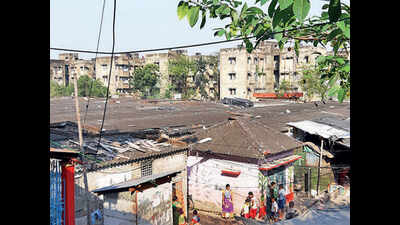- News
- City News
- kolkata News
- Social distancing takes a walk in Kolkata’s 3,000 slums with 18 lakh people
Trending
This story is from April 15, 2020
Social distancing takes a walk in Kolkata’s 3,000 slums with 18 lakh people
Be it winter, summer or monsoon, Tiljala’s Dharapara slum resident Tapan Sutradhar wakes up around dawn to use the community toilet before the queue becomes too long. Since the lockdown was announced, he has become even more paranoid and wakes up in the early hours before sunrise to use the toilet before the crowd builds up.

In large slums with population of over 10,000, one toilet is used by 25-30 persons daily. The ratio was even more skewed till recently. In the past five years, 10,000 toilets have been added in slums
KOLKATA: Be it winter, summer or monsoon, Tiljala’s Dharapara slum resident Tapan Sutradhar wakes up around dawn to use the community toilet before the queue becomes too long. Since the lockdown was announced, he has become even more paranoid and wakes up in the early hours before sunrise to use the toilet before the crowd builds up.

Mohammed Aslam, who lives in Belgachhia slum, can do nothing to avoid the queue when he goes to fetch water from the community tap.With KMC supplying water at 4pm, men, women and children from several households in the slum queue up to fill their buckets and bottles.
Sutradhar and Aslam are among lakhs residing in Kolkata’s congested slums where residents can’t even visualise social distancing, much less practice it. With 25-30 persons sharing a toilet and over a 100 using the same drinking water source, social distancing is as abstract a concept among slum residents as it is impossible to practise.
KMC officials concede the social distancing norms made little sense in the slums where residents had to compete to avail of facilities in time. “In summer, 600-700 slum dwellers queue up twice a day at a roadside tap for drinking water. Then there are toilets, few in numbers that have to cater to many that live there. Maintaining the level of personal hygiene being advocated to avoid Covid-19 in a situation such as this is well nigh impossible,” the official from the KMC slum development department admitted.
In large slums with population of over 10,000, one toilet is used by 25-30 persons daily. The ratio was even more skewed till recently. In the past five years, 10,000 toilets have been added in slums.
Swapan Samaddar, member mayor-in-council overseeing the slum development department at KMC, is a worried man. “There are slums where 10-12 people share a 250 square feet room. What can you do in a situation such as this?” he wonders.
At least 18 lakh people stay in more than 3,000 slums located across the city. Of these, 23 are major slums with a population of over 10,000 people.
Given the conditions and vulnerability to high transmission in case a resident contracts the virus, all major slums have been categorised as high-risk zones for concerted Covid-19 prevention drives. These include fever checks among sanitisation drives to keep the alleys clean.
“We can’t enforce social distancing due to want of space. What we can do is keep a vigil on people running a temperature and sanitize the slums twice daily,” the official said.

Mohammed Aslam, who lives in Belgachhia slum, can do nothing to avoid the queue when he goes to fetch water from the community tap.With KMC supplying water at 4pm, men, women and children from several households in the slum queue up to fill their buckets and bottles.
Sutradhar and Aslam are among lakhs residing in Kolkata’s congested slums where residents can’t even visualise social distancing, much less practice it. With 25-30 persons sharing a toilet and over a 100 using the same drinking water source, social distancing is as abstract a concept among slum residents as it is impossible to practise.
While fear runs deep among a section of slum dwellers on how the virus could spread its tentacles through the narrow alleys and cheek by jowl tenements if a resident contracted it, they have to go about with their lives.
KMC officials concede the social distancing norms made little sense in the slums where residents had to compete to avail of facilities in time. “In summer, 600-700 slum dwellers queue up twice a day at a roadside tap for drinking water. Then there are toilets, few in numbers that have to cater to many that live there. Maintaining the level of personal hygiene being advocated to avoid Covid-19 in a situation such as this is well nigh impossible,” the official from the KMC slum development department admitted.
In large slums with population of over 10,000, one toilet is used by 25-30 persons daily. The ratio was even more skewed till recently. In the past five years, 10,000 toilets have been added in slums.
Swapan Samaddar, member mayor-in-council overseeing the slum development department at KMC, is a worried man. “There are slums where 10-12 people share a 250 square feet room. What can you do in a situation such as this?” he wonders.
At least 18 lakh people stay in more than 3,000 slums located across the city. Of these, 23 are major slums with a population of over 10,000 people.
Given the conditions and vulnerability to high transmission in case a resident contracts the virus, all major slums have been categorised as high-risk zones for concerted Covid-19 prevention drives. These include fever checks among sanitisation drives to keep the alleys clean.
“We can’t enforce social distancing due to want of space. What we can do is keep a vigil on people running a temperature and sanitize the slums twice daily,” the official said.
End of Article
FOLLOW US ON SOCIAL MEDIA










